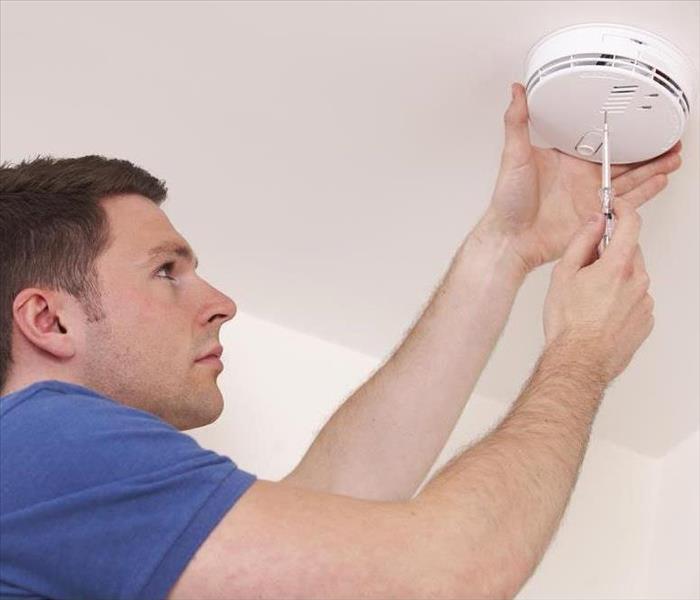Archived Fire Damage Blog Posts
Preventing Heating Fires
2/8/2024 (Permalink)
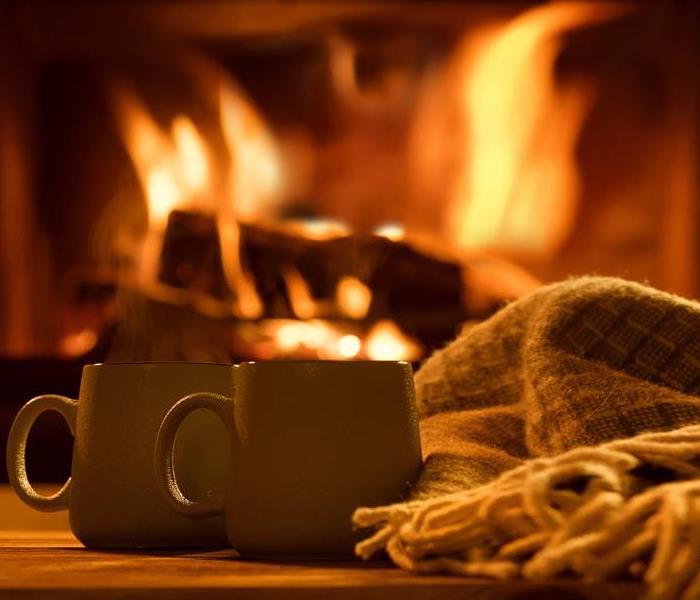 Heat your home safely this season as the cold outdoor temperatures persist.
Heat your home safely this season as the cold outdoor temperatures persist.
While modern heating systems are designed to be more efficient and have built-in safety features that minimize the risk of fires, it is crucial to note that heating fires can still occur due to various factors.
Is your property at risk? Let us help you get prepared with our checklist of preventative measures. But remember, if your property does undergo damage, we are open 24/7, 365 days a year to help you through it and to make it "Like it never even happened."
Overall, there has been a decline in heating fires over the years, however, they still pose a significant risk to homes and individuals. By remaining vigilant, staying informed about safety measures, and taking proactive steps to maintain heating systems, we can continue to reduce the occurrence of these devastating incidents.
Checklist for preventing heating fires
- Heat source proximity - Keep anything that can burn at least three feet from all heat sources including fireplaces, wood stoves, radiators, portable heaters, or candles.
- Electrical issues - Always plug space heaters directly into an outlet, and make sure its cord isn’t damaged or frayed.
- Improper usage - Never use an oven to heat your home.
- Maintenance - Maintain heating equipment and chimneys by having them cleaned and inspected each year by a professional.
- More information - Visit the U.S. Fire Administration Home Fires page to learn about how to prepare for and prevent home fires including tips for individuals with disabilities and older adults.
source: Ready.gov
Was this helpful? Leave us a review to let us know!
https://www.wereyouhappy.com/review2/SERVPRO-of-west-knoxville
Fire Prevention for Homes and Businesses
12/7/2023 (Permalink)
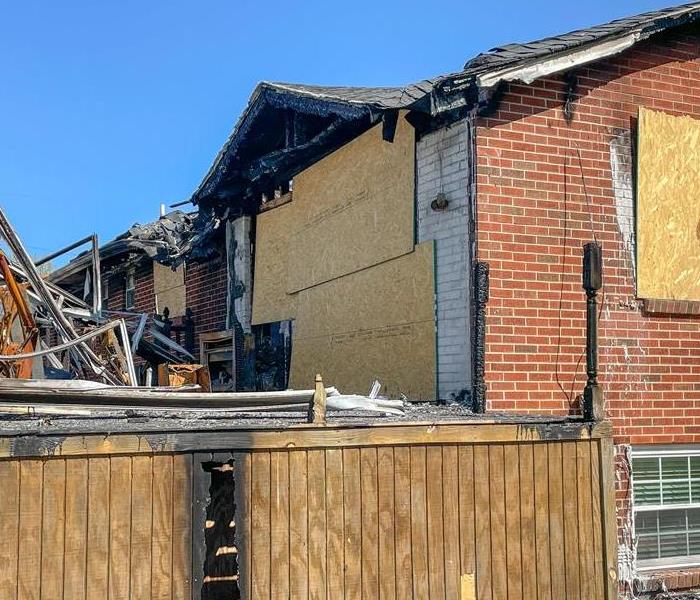 The effects of a fire can be devistating.
The effects of a fire can be devistating.
If you didn't know, it's National Fire Prevention Week. As much as we here at SERVPRO are here to help clean up after fires, our priority is always to help prevent them in the first place. So, we want to share some tips with you that will help keep you and your loved ones safe.
Fire is one of the most devastating disasters that can strike a home or business. It can cause extensive damage to property and possessions, and can even lead to loss of life. That's why it's important to take steps to prevent fires from happening in the first place.
Here are some fire prevention tips for homes and businesses:
Home fire prevention tips:
? Install smoke alarms on every level of your home, inside bedrooms and outside sleeping areas. Test your smoke alarms every month and change the batteries every year.
? Create and practice a fire escape plan with your family.
? Keep flammable materials away from heat sources.
? Be careful when cooking and using candles.
? Never smoke in bed.
? Have your electrical wiring and appliances inspected regularly by a qualified electrician.
Business fire prevention tips:
? Install smoke alarms and carbon monoxide detectors throughout your business. Test your alarms every month and change the batteries every year.
? Create and practice a fire escape plan with your employees.
? Keep flammable materials away from heat sources and electrical equipment.
? Be careful when using appliances and equipment.
? Have your electrical wiring and appliances inspected regularly by a qualified electrician.
How SERVPRO can help after a fire
If a fire does happen, it's important to call a qualified fire restoration company as soon as possible. SERVPRO is a leading provider of fire restoration services. We have over 2,000 franchises across the United States and Canada, so we're always nearby to help when disaster strikes.
Our team of highly trained and experienced professionals is equipped to handle all aspects of fire restoration, including:
? Emergency water removal
? Structural drying
? Smoke and odor removal
? Content cleaning and restoration
? Construction services We work with your insurance company to make the claims process as easy and stress-free as possible. We also offer 24/7 emergency service, so you can always count on us to be there for you when you need us most.
If you have experienced a fire, contact SERVPRO today. We're here to help you get your home or business back to normal as quickly as possible.
Additional fire prevention tips:
? Educate your family and employees about fire safety. Make sure everyone knows what to do in case of a fire.
? Have a fire extinguisher on every level of your home or business and know how to use it.
? Keep your fire extinguishers in good working order by inspecting them regularly and having them serviced by a professional.
? Consider installing a fire sprinkler system. Fire sprinkler systems can help to extinguish fires quickly and prevent them from spreading.
By following these fire prevention tips, you can help to protect your home or business from the devastating effects of fire.
The ABCs of a Home Fire Extinguisher
7/27/2022 (Permalink)
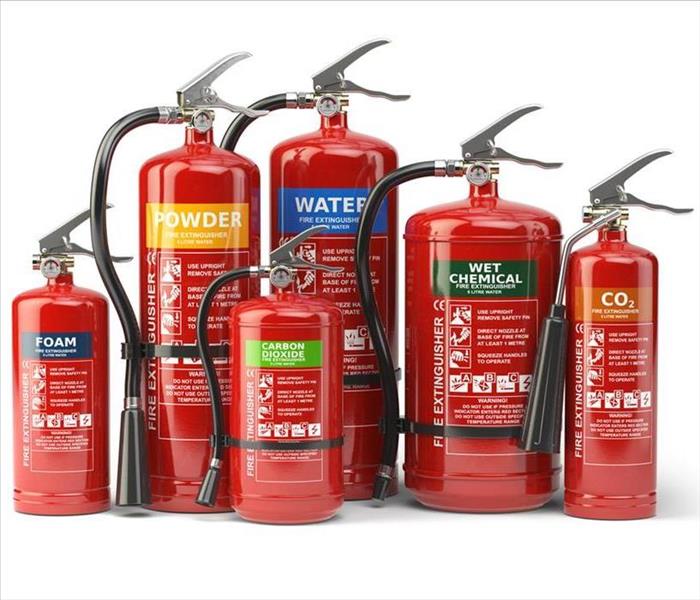 Don't choose an extinguisher that is too heavy to lift.
Don't choose an extinguisher that is too heavy to lift.
Homeowners should own a number of critical devices for fire protection and preparedness. Fire alarms in every sleeping room and on every level are a must. It's also important to regularly check that they are functioning and that the batteries still work. A fire extinguisher in the home is also a necessary tool. Equally important is to know how to use the implement and to understand what type of fire it will work on. The extinguisher should be placed in an easy-to-reach place and in proximity to a potential fire zone, such as the kitchen or near a wood-burning stove. In the best of worlds, your home in Oak Ridge, TN, will be equipped with multiple extinguishers, including at least one on every floor.
What Type of Fire Extinguisher
Remember, a home extinguisher is primarily to put out fires quickly. It can prevent a small home fire from engulfing your entire home. When looking for the perfect model for your home, consider these factors:
- Is it the right size for the user?
- Is it rechargeable or disposable after one use?
- Will it put out all types of fires, including an electrical fire?
- How effective will it be?
Knowing the answers to these questions increases your fire preparedness. Don't choose an extinguisher that is too heavy to lift. Understand what the A, B and C labels refer to: A is for wood, paper and cloth fires; B is for flammable liquids such as cooking oil or gasoline; C is for a live electrical fire.
How To Operate
The acronym PASS is helpful when you have to suddenly operate a fire extinguisher. First, you Pull the pin, next you Aim the chemical at the source of the flames, then you Squeeze the trigger and finally, you Sweep the extinguisher at the flames until it runs dry. When the fire is out, be sure to call in a fire remediation team in Oak Ridge, TN, to begin a professional fire cleanup.
5 Essential Elements of a Fire Management Plan
5/10/2022 (Permalink)
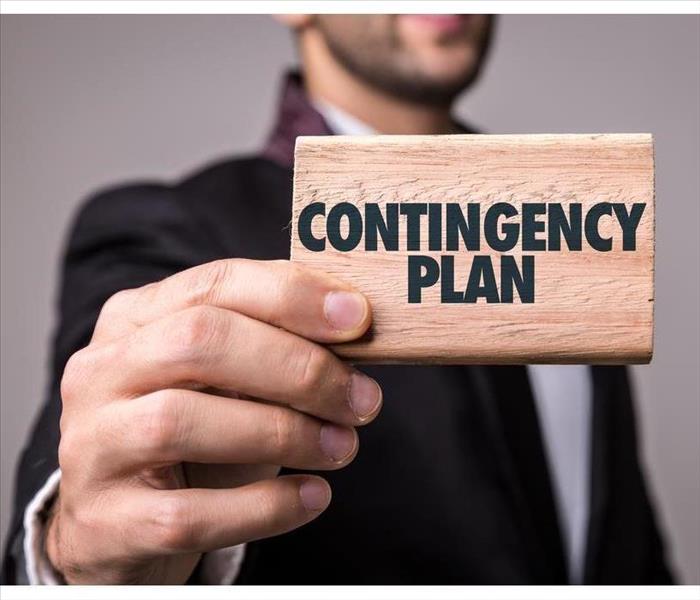 A smart company always has a contingency plan for unpredictable events.
A smart company always has a contingency plan for unpredictable events.
How To Deal With Disasters Such As a Fire
A smart company always has a contingency plan for unpredictable events. This could include discussing what to do if a top manager becomes sick or if the economy goes into a deep recession. It also covers how to deal with disasters such as a significant fire. Solid preparation covers everything from fire prevention to dealing with the aftermath of a sudden blaze.
1. Fire Prevention
Stopping a fire before it begins is often the most effective approach, though it can never be guaranteed. Putting in fire alarms, equipping a facility with fire extinguishers and installing a sprinkler system are all excellent investments.
2. Fire Readiness
Focusing on what happens after a fire starts can have many benefits for a company. It can reduce injuries and even save lives. It informs employees and others where to go should a fire break out. An evacuation plan has the details written down in plain language and posted in strategic places so personnel can quickly get to a place of safety.
3. A Contingency Plan
This is a more detailed implementation of evacuation readiness. It lists resources such as fire departments and other emergency personnel in Oliver Springs, TN. It has the backing of most fire organizations and might even be a legal requirement in some communities.
4. Fire Cleanup
A rapid response after a fire has been put out is essential to a company's survival. A professional fire mitigation team has the training and the equipment to clean up soot and smoke damage, clean and sanitize walls and eradicate smoke odors.
5. Building Restoration
Hot flames can do a lot of structural damage to a commercial facility. For the business to function again, quality restoration is needed to return the building to its pre-fire condition.
A contingency plan can protect a company in hard times. Fire management is needed for companies large and small.
Should You Upgrade to a Smart Detector?
4/17/2022 (Permalink)
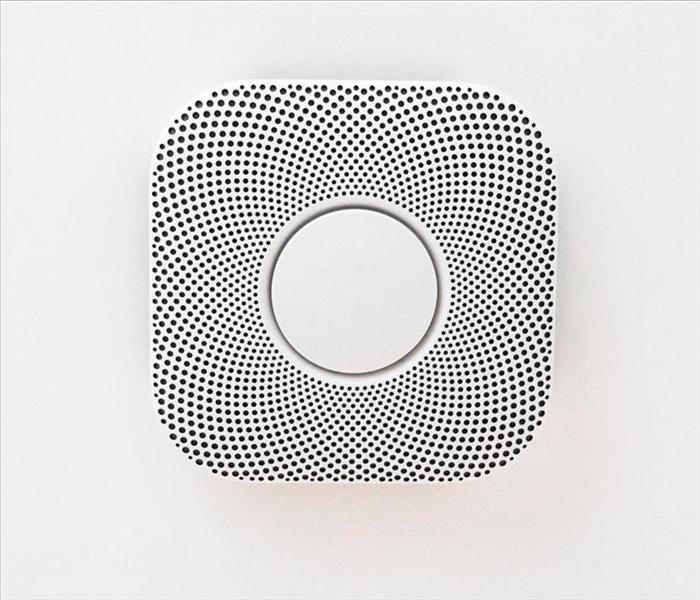 A smart detector uses traditional technology, but it can notify you and alert emergency services.
A smart detector uses traditional technology, but it can notify you and alert emergency services.
Should You Consider Purchasing a Smart Detector?
While households in Norris, TN, have used the lifesaving benefits of smoke alarm systems for decades, smart detectors are now on the market. Before you decide whether to upgrade, you can take a look at the different kinds of detectors and how they function.
Detectors fall into these main categories:
- Ionization
- Photoelectric
- Dual-sensor
What Is an Ionization Smoke Detector?
This type of detector has two electrically charged plates with a small amount of radioactive material between them. Electric current flows as the air in the middle is ionized. When smoke gets into the ionized space, it interrupts the ion flow, reducing the current and triggering an alarm. Ionization detectors respond slightly faster to fires that produce lots of flames.
What Is a Photoelectric Smoke Alarm?
A photoelectric alarm has a light beam in a chamber at an angle to the sensor. When smoke enters the chamber, it reflects light onto the sensor and triggers an alarm. Photoelectric smoke detectors are slightly more sensitive to smoldering fires.
The U.S. Fire Administration said both alarms will detect smoldering and flaming fires, but because no one can predict a type of fire, it is best to have both kinds or a dual-sensor alarm for fire safety.
What Is a Smart Detector?
A smart detector uses traditional technology, but it can notify you and alert emergency services when no one is home because it connects to the internet. This technology can save you from a more extensive fire that might require mitigation from an emergency restoration company.
You can also choose a device called a listener, which alerts you when it picks up the specific frequency of an alarm. Another option is a smart battery, which fits an alarm like a 9-volt battery but notifies you if the alarm is activated or the battery is low.
You have many options when it comes to choosing a smoke alarm system. A smart detector offers some advantages over traditional detectors, but the most important choice you can make is to keep a working system in your home at all times.
How To Respond to Burns in the Workplace
3/29/2022 (Permalink)
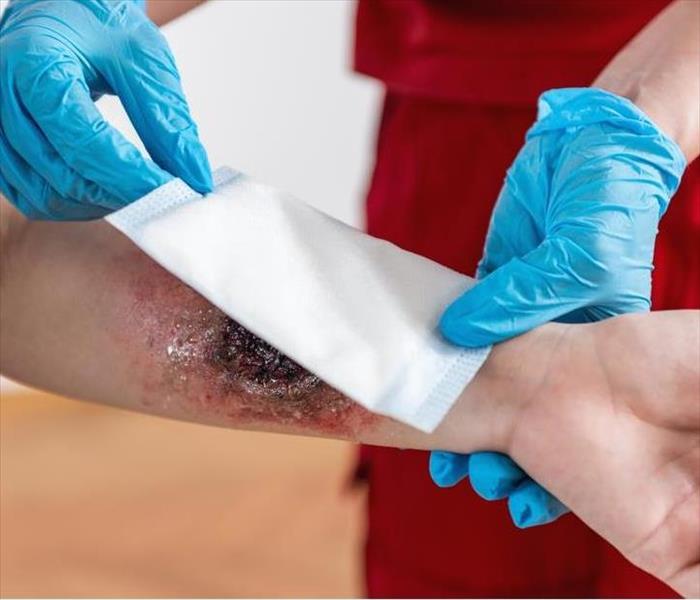 Minor burns can usually be managed without medical assistance.
Minor burns can usually be managed without medical assistance.
What to Do If You Get Burned at Work?
A fire safety plan is an essential for business owners, and part of that plan must include how to response when fire damage directly affects a staff member or a customer. Are you prepared to treat burns and administer first aid? Take a look at important steps for preventing injuries and an overview of the appropriate treatment steps.
Prevent Burns
The best scenario is to avoid using the burn first kit altogether. Use the following tips to decrease the possibility of fire in your workplace. Prevention starts by recognizing the three most common workplace burns:
- Thermal (heat)
- Chemical
- Electrical
Preventing burns starts with compliance with OSHA standards and MSDS safety protocols. The next step is to train employees according to your company safety plan. Finally, consistently maintain building safety systems and reinforce safe behaviors in your employees.
Contact Emergency Services
When fire damage affects the building, one of your first steps should be to contact emergency personnel and fire remediation and reconstruction experts. The same is true when an employee or customer is injured; immediately contact emergency medical professionals. With paramedics or EMTs on the way, it's time to implement some basic burn first aid.
Treat Minor Burns
Minor burns can usually be treated simply and without medical help:
- Cool the burned area.
- Remove jewelry and other tight items before swelling sets in.
- Leave blisters alone.
- Treat the area with a moisturizing lotion or aloe vera.
- Apply a sterile gauze bandage.
Treat Major Burns
Major burns require more attention. While waiting for the medical technicians to arrive, take the following steps:
Move the burned individual away from further harm.
Check for breathing. If the person isn't breathing, begin rescue breathing as appropriate.
Remove jewelry, belts, and other tight items before the person begins swelling.
Cool the burned area with a moist cloth or bandage.
Elevate the affected body parts above heart level.
Don't submerge large burns in water.
Hopefully, your Clinton, TN, business won't be affected by fire. However, it's best to take steps to reduce the possibility of fire damage and prepare for the worst with appropriate first aid training.
A Homeowner’s Policy Does Not Cover All Fires
2/25/2022 (Permalink)
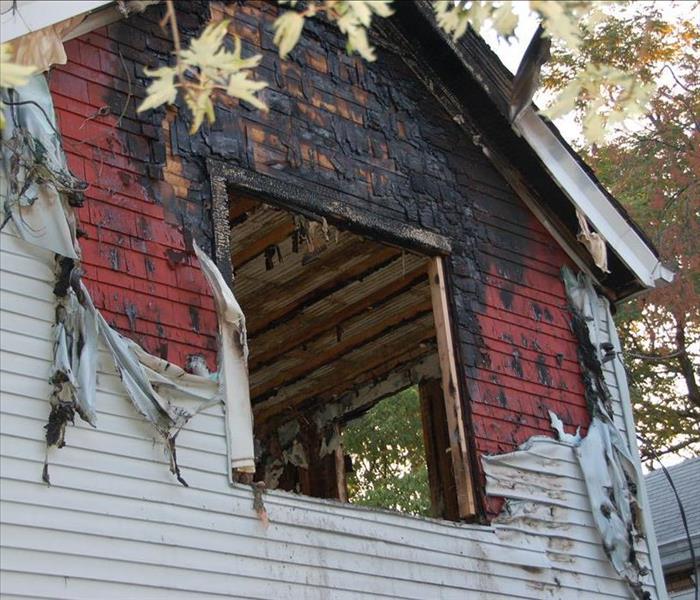 A home fire in Rocky Top, TN.
A home fire in Rocky Top, TN.
A Homeowner's Insurance Policy Does Not Cover All Types of Fires.
When it comes to a home fire, the fine print in your policy is your insurer’s friend. It describes the items and circumstances excluded from your fire coverage. They may use fine print to save paper. They may hope it’s too small for you to read. Look at your policy and decide for yourself. One fact you can be sure of is that the fine print is in policies everywhere, not just those in Rocky Top, TN.
Imagine having a fire where your insurer denied your claim. It would be a financial disaster that could drive you into bankruptcy. Imagine being in this situation:
- There would be no money for home repairs or replacement.
- There would be no money to replace the contents and personal items.
- There would be no money for relocation expenses.
- Mortgage payments would still be due.
- You would be homeless.
Naturally, you would appeal the decision and take them to court if necessary. There are two common reasons for denial of the claim.
Insurers Don’t Cover Fires Started by Arsonists
Many people find themselves upside down on their home mortgages. They can’t afford to keep their home, and they can’t afford to sell it. They are stuck. They fantasize about a home fire solving their problem. They would be happy to let the insurance company deal with it.
Sometimes, people will take that fantasy a step further and cause the fire. That is arson and is illegal. It gives the insurer a reason to deny the claim.
A Standard Policy Will Not Cover a Vacant Home Fire
Insurers typically consider a home vacant if unoccupied for 30 days or more. If someone regularly checks on it, is it vacant? If renovations are underway during the daytime, is it vacant? Could an insurer consider your home vacant? If so, be safe and buy a policy endorsement that covers this situation.
After a home fire, you want to recover as quickly as possible. There are fire restoration professionals nearby, ready to come to the rescue. They are here to help.
Dryer Maintenance for Fire Prevention
12/31/2021 (Permalink)
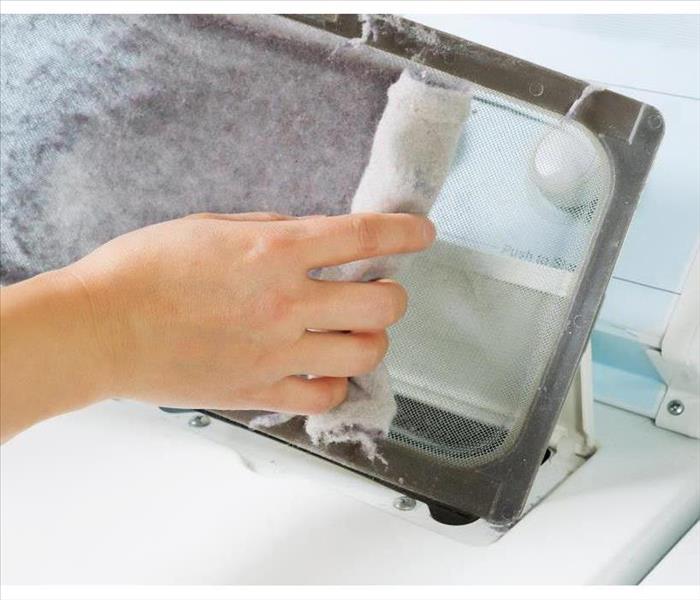 Clean lint filters every time you dry a load of laundry.
Clean lint filters every time you dry a load of laundry.
Dryer Maintenance for Fire Prevention
The clothes dryer is a modern convenience people in Claxton, TN, use every day without a second thought. However, if these appliances aren’t properly maintained, there is an increased risk of lint fire and dryer fire. Statistics show 77 percent of dryer fires occur in one- and two-family residences, with 34 percent caused by failure to clean the appliance and 28 percent caused specifically by dust, fiber and lint in the machine.
How It Happens
When clothes are dried, they shed small fibers that create lint. This lint is then either collected in the lint trap or expelled through the dryer’s exhaust vent. It is when the lint trap and the exhaust vent aren’t cleaned that fires can occur. When the lint trap is full or the exhaust is blocked by lint or even small rodent nests, it prevents hot air from escaping the machine. The resulting heat buildup can cause the debris to ignite, resulting in fire.
How To Prevent It
The easiest way to protect against a lint fire is with regular maintenance. However, if you notice your clothes are taking longer than usual to dry or they are coming out of the machine hotter than normal, these are signs that you may have a blocked dryer vent and you should check it immediately. Otherwise, following these tips can decrease the chance of fire and improve your safety:
- Use only flexible transition ducts listed by an approved safety testing agency to vent dryer exhaust
- Only vent dryer exhaust to the outside of the home
- Clean lint filters every time you dry a load of laundry
- Clean exhaust vents every three months
- Clean lint buildup from the area behind the dryer every six months
These precautions can help protect you, but accidents can always happen. If you do have a dryer fire or lint fire in Claxton, TN, contact your insurance company and a professional cleanup team for the fastest recovery.
Cleaning Your Belongings After a Fire: 3 Steps To Take
10/22/2021 (Permalink)
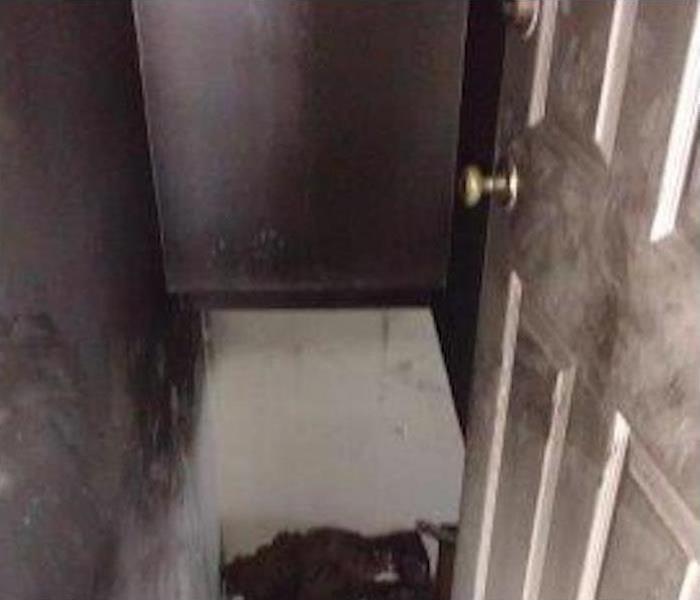 Fire damage in a hallway of a home in Clinton, TN.
Fire damage in a hallway of a home in Clinton, TN.
Cleaning Items After a Fire
After a fire damages your Clinton, TN, home, facing the task of cleaning your belongings can be a challenge. Your clothing, furniture, carpeting and other items might have all suffered smoke and soot damage that can be difficult to remove on your own. However, there are some steps you can take to restore them, from sorting restorable belongings to having a fire remediation and restoration company use dry cleaning techniques and other industrial machinery to salvage as many possessions as possible after a blaze.
1. Gauge What Might Be Saved
Once fire officials have let you know it is safe to re-enter your home, the first step you may want to take is sorting through smoke-damaged items and finding those that could still be salvaged. Most non-porous items, such as metal kitchen items and certain types of building materials can be wiped clean or sanitized in boiling water.
2. Sort Out Saved Items
Once you find items you wish to salvage, sort them into piles so the company that handles your content cleaning does not have to work with one large pile of different belongings. This can also make the process more efficient. If any of the items have both smoke and water damage, keep these separate and ask your restoration company if they will require a different restoration process.
3. Note Building Cleaning Requirements
While restoration specialists can use dry cleaning machines on your clothing and other items, cleaning soot and smoke from your walls, ceiling and carpeting may be more of a challenge. As you note which rooms have sustained such damage, you can work with your fire damage techs and discuss whether you will require content storage for your cleaned items while stationery sections of your home are cleaned with industrial foggers and air sanitizing machines.
Cleaning items after a fire affects your Clinton, TN, home does not have to be an insurmountable task. From sorting your items efficiently to reaching out to a professional restoration company for dry cleaning and air purification services, there are several steps you can take to reclaim your property from the ravages of fire.
Essential Elements of an Emergency Fire Plan
7/22/2021 (Permalink)
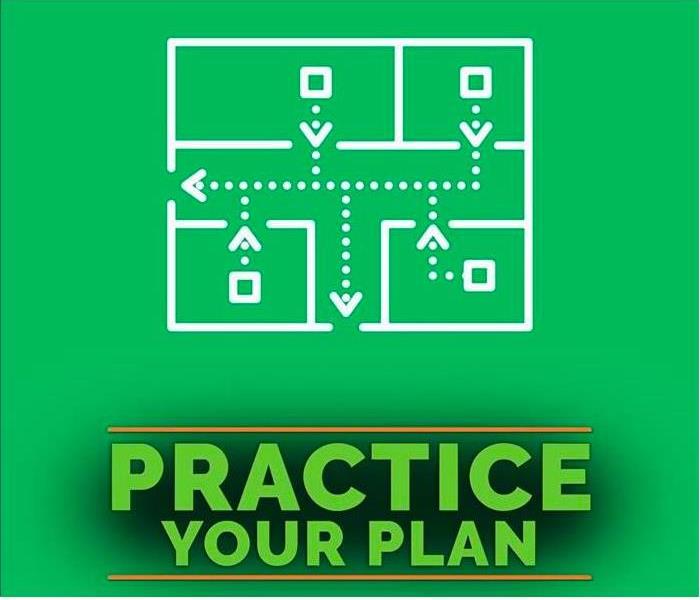 Creating a fire escape plan with your whole family can ensure everyone knows what to do if a fire breaks out.
Creating a fire escape plan with your whole family can ensure everyone knows what to do if a fire breaks out.
The Basics Of An Emergency Fire Plan
As a homeowner in Andersonville, TN you want to be prepared for anything that comes your way. That's why you should create a fire escape plan with your family. This plan can help you and your loved ones know what to do in the case of an emergency. Use these tips from the American Red Cross to ensure you're ready:
• Know Who To Call: Part of your emergency escape plan should be knowing what to do once you're safely outside. This can include calling emergency responders, your insurance provider and a fire restoration team.
• Establish Safety Tactics: When escaping from the house, your family may need to leave in a unique fashion. For example, if anyone's clothing catches on fire, they may need to stop, drop and roll. If the house is filled with smoke, people may need to crawl out of the house.
• Think of Alternate Routes: Everyone knows how to exit the front door of your house, but this typical escape route might not be available during a fire. You and all of your family members should have at least two ways to get out of every room in the house. Don't forget going out a window may be necessary.
• Pick Out a Meeting Spot: During a fire, your family may have to leave the house from different points. Your fire escape plan should include a meeting spot that is a safe distance from the house.
• Establish Emergency Communication: In some unique cases, someone may not be able to make it to the family meeting spot. Everyone should know to talk with the emergency responders about who hasn't shown up outside of the home yet.
Creating a fire escape plan with your whole family can ensure everyone knows what to do if a fire breaks out. Once you have this plan created, you should practice it at least twice a year.
Choose The Right Professional For Fire Damage
7/12/2021 (Permalink)
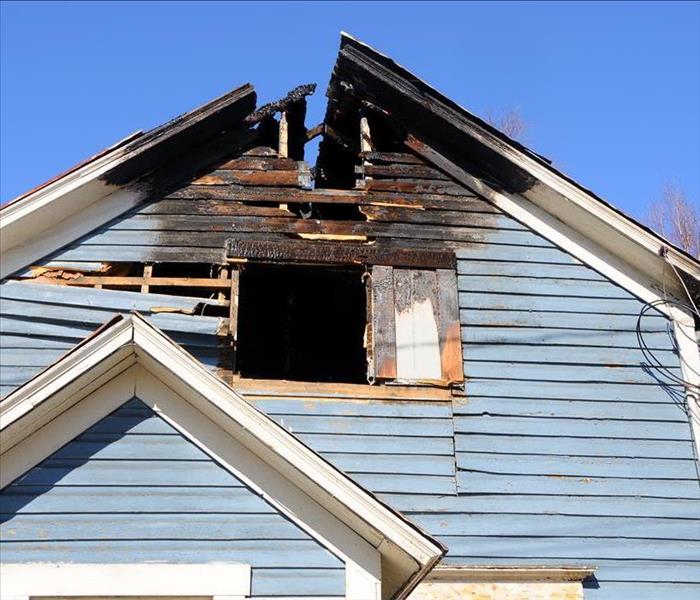 Fire damage to a home in Clinton, TN.
Fire damage to a home in Clinton, TN.
Choose The Right Professional For Fire Damage
In the wake of a residential fire, the primary focus is on repairing the damage done to the inside of the house. However, moderate to severe incidents can lead to visible marks and blemishes on the outside of the building too. It is why SERVPRO conducts a full inspection of fire-damaged properties before we start any restoration work.
The good news is that stains on masonry, concrete and other structural materials are almost always superficial. While brick and concrete are not impervious to fire damage in Clinton, TN homes, they are incredibly sturdy and don’t succumb easily to heat. It means that, in most cases, we can use straightforward cleaning techniques to restore the outside of the property.
Light Stains
If there is no structural damage to the masonry, the SERVPRO technicians use mild cleaning agents to wash soot and smoke deposits from the surface. Where the staining is very light, dry sponging is enough to wipe away the grime on block, brick, and concrete. Stubborn marks get lifted with alkaline detergents and direct scrubbing. Sodium hypochlorite is highly active when it comes to soot removal, and it leaves no residues.
Moderate Stains
The problematic thing about soot is that it can be highly acidic. If it is not removed quickly, particularly from structural materials, there is a chance of corrosive residues becoming embedded more profound and more in-depth into the masonry. It is why SERVPRO pays close attention to cracked joints.
They are delicately cleaned and repointed to dislodge any soot deposits which may be trying to move into the capillaries. Once this is complete, larger areas are dry, sponged, and vacuumed. Then, they are jet washed with a high-powered pressure cleaning device.
Heavy Stains
The most severe staining occurs when heavily combustible materials have caught fire and burned for some time. In some cases, jet washing is still a suitable method of cleaning. We can add soot dissolving formulas like high PH degreasers, dry ice, or soda ash to increase optimal results.
SERVPRO rarely recommends sandblasting for brick, block, and concrete because it is a very abrasive process and can cause additional damage. If there are smaller patches of masonry which are heavily soiled, the technicians may apply a poultice (sodium hypochlorite and diatomaceous earth). It takes 24-48 hours for the formula to take effect.
The great thing about a fire damage restoration company like SERVPRO is that we offer a complete package. We are part of a vast network of contractors, so there is no repair job too big for our team to handle.
How To Prevent Electronics From Causing Extreme Water Damage
6/7/2021 (Permalink)
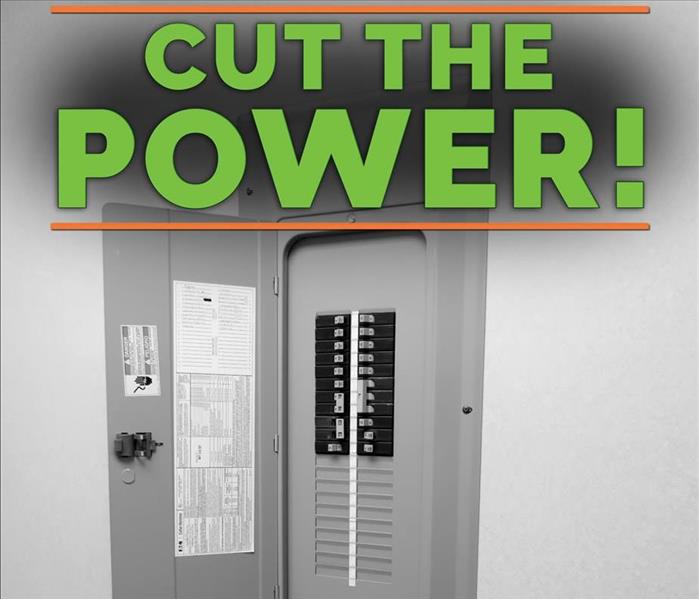 Shut off the electricity at the breaker level.
Shut off the electricity at the breaker level.
How To Prevent Electronics From Causing Extreme Water Damage
Water damage can occur for many different reasons. Sometimes, it happens as a result of a flood due to heavy rains. Other times, it may be due to an inside flood, such as when a pipe or a water heater bursts. Whatever the case may be, if you are dealing with water damage or water-damaged electronics, appliances, or other devices, you need to proceed with extreme caution. The best thing you can do, after water damage has occurred, is to call on Nashville professionals who are familiar with dealing with such loss, such as our skilled pros at SERVPRO of Oak Ridge. In the meantime, make sure you practice some excellent safety tips with water-damaged devices.
First things first, before you start thinking about possible water damage restoration, you need to make sure that you are not in immediate danger and that the devices that you own are not going to cause a fire or another dangerous incident.
After water damage has occurred, check your home to see if you have any damaged devices plugged in. If you find that you do, shut off the electricity at the breaker level. This will keep damaged devices from being able to start a fire. You should not touch, go near, or inspect any devices that are plugged in until you are sure that the electricity is off. Following this critical tip will help you to avoid electric shock.
Believe it or not, it is not only plugged-in water-damaged electronics that pose a risk. Any device that contains a battery can also pose a severe threat. Thus, it's best to let our pros at SERVPRO of Oak Ridge handle any such tools if you think they may have been damaged. At the very least, before touching any battery-operated device, ensure that it is not giving off heat or smoke, bulging, melting, or making strange sounds. All these types of things are significant warning signs that something serious and potentially dangerous is wrong with the battery!
As you can see, you're not always in the clear once the water subsides! To keep safe, contact the experts at SERVPRO of Oak Ridge before you do anything. At the very least, follow these simple tips to keep yourself and your loved ones safe.
The Importance of Fire Alarms
4/30/2021 (Permalink)
Smoke alarms save lives when properly installed and maintained, according to the National Fire Protection Association
(NFPA). In homes, smoke alarms should be in every bedroom, outside each sleeping area, and on every level, including the basement. Extra smoke alarms may be needed in large homes.
Test smoke alarms monthly using the test button. Smoke alarms with
non-replaceable batteries need the entire smoke alarm unit replaced every ten years. Other alarms need batteries replaced every year, and the unit replaced every ten years. If the alarm chirps signaling low battery, take the proper steps to replace the unit or the batteries immediately. Never disable or remove the battery from an alarm. Almost half of the fires where smoke alarms were present but did not activate had missing or disconnected batteries (NFPA).
If you need help installing, testing or changing batteries in your smoke
alarms, contact your local fire department, an electrician or the American Red Cross. Be sure your home has a fire emergency plan in place and conduct regular fire drills with your family. For more information on Emergency Preparedness, contact SERVPRO of Oak Ridge.
Winter Holiday Safety
12/10/2020 (Permalink)
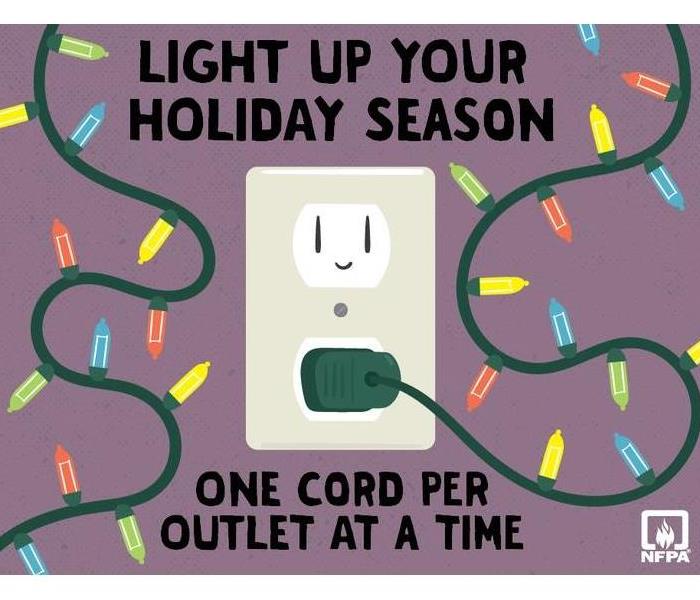 Happy Holidays from SERVPRO of Oak Ridge!
Happy Holidays from SERVPRO of Oak Ridge!
Holiday Decorating
Winter holidays are a time for families and friends to get together. But that also means a greater risk for fire. Here at SERVPRO of Oak Ridge love decorating for Christmas just as much as anyone else! There can be risks that the regular person may not consider when making their home a Winter Wonderland. The National Fire Protection Association (NFPA) has a few simple tips that will ensure a happy and fire-safe holiday season.
- Be careful with holiday decorations. Choose decorations that are flame resistant or flame retardant.
- Keep lit candles away from decorations and other things that can burn.
- Some lights are only for indoor or outdoor use, but not both.
- Replace any string of lights with worn or broken cords or loose bulb connections. Read manufacturer’s instructions for the number of light strands to connect.
- Use clips, not nails, to hang lights so the cords do not get damaged.
- Keep decorations away from windows and doors.
From our Team to your home, we want to wish you all a Happy Holiday! Stay safe, health, and jolly! We are available 24/7 all year long! Give us a call if a loss occurs!
Don’t Count Out Sprinkler Systems in Your Home Just Yet!
10/15/2020 (Permalink)
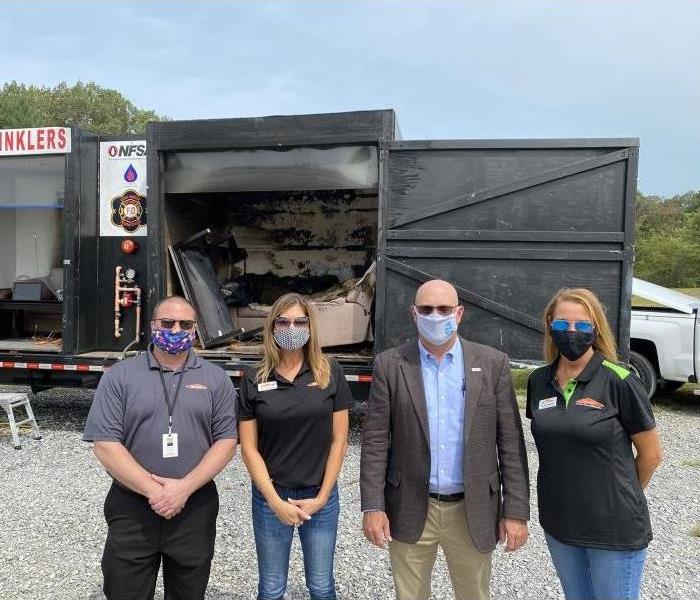 Our team members with the President of the NFSA, Shane Ray.
Our team members with the President of the NFSA, Shane Ray.
Don’t Count Out Sprinkler Systems in Your Home Just Yet!
It hasn’t been the most common house renovation in the past, but here at SERVPRO of Oak Ridge, we believe that home sprinkler systems have major benefits if a fire were to occur in your home.
We know that there are many myths about if one sprinkler head was triggered that would cause the whole system to activate, which isn’t the case. The National Fire Protection Association (NFPA) states “Each individual sprinkler is designed and calibrated to activate only during the heat from a fire. They do not operate in response to smoke, burned toast, cooking vapors, steam, or an activating smoke alarm.”
Maybe you’re thinking that a smoke alarm is enough, well smoke alarms alert occupants to the presence of danger but do nothing to extinguish the fire. Home fire sprinklers respond quickly to reduce heat, flames, and smoke from a fire, giving residents valuable time to get out safely. Having a working smoke alarm cuts the chances of dying in a reported fire in half. However, if you have a reported fire in your home, the risk of dying decreases by about 85% when sprinklers are present.
Our team recently attended a Burn Event hosted by the Oak Ridge Fire Department and the National Fire Sprinkler Association. At this event, there were two units, one with and one without sprinklers and our team got to see firsthand how quickly a home can go up in flames when sprinklers aren’t involved.
Even though the side with a sprinkler system will have water and fire damage most of the items will not be destroyed, that’s where SERVPRO of Oak Ridge would come and extract water and start the drying process as well as treat the smoke damaged content to make the items as good as they were before the fire took place. In the unit without sprinklers, the items will more than likely be destroyed beyond repair.
If you would like to watch our video with the President of the NFSA click here! Shane Ray explains further why sprinklers could be a way to prolong your chances of you and your family getting out of a fire safely.
Smoke Alarms
4/1/2020 (Permalink)
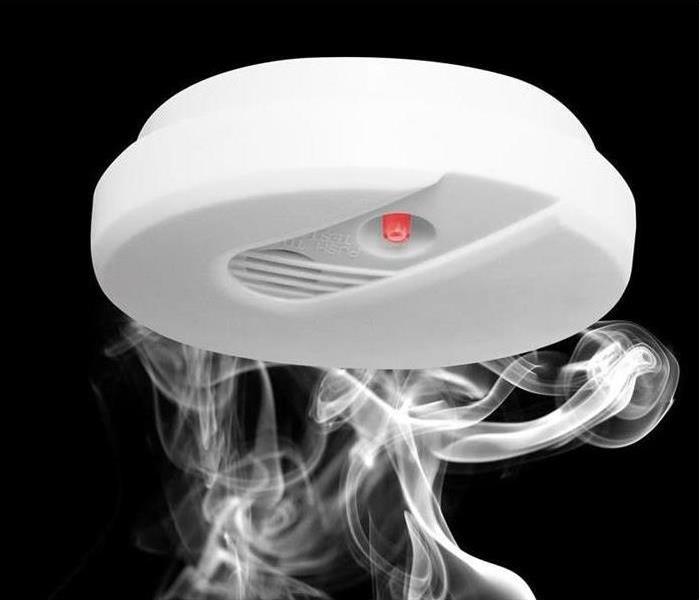 Smoke Damage
Smoke Damage
SMOKE ALARMS
Smoke alarms play a vital role in saving lives, and when properly installed, can reduce the risk of fire injury by half.
The National Fire Protection Association recommends smoke alarms be installed in every bedroom, outside all sleeping quarters, and on every level of the house. Business owners should consult the local Fire Marshall to ensure specific building fire codes and smoke detector requirements are met.
Smoke alarms work best when paired with a fire escape plan. A plan allows your family, employees, or clients to escape quickly and safely in an emergency.
Review the following tips regarding smoke detector installation and maintenance. For more on emergency preparedness, contact SERVPRO of Oak Ridge.
Install smoke alarms on every level of the home, including the basement.
Smoke alarms should be installed away from the kitchen to prevent false alarms. Generally, they should be at least 10 feet from the cooking appliance.
Test smoke alarms at least once a month using the test button.
Replace batteries in all smoke alarms at least once a year. If an alarm “chirps” the battery is low and should be replaced right away.
Replace all smoke alarms when they are ten years old.
Fire Prevention Month
12/5/2019 (Permalink)
October is Fire Prevention Month, a perfect time to examine emergency preparedness plans for your home and business, including your fire escape plan. Do you have a fire escape plan? Have you changed your smoke alarm batteries within the last year?
The National Fire Protection Association (NFPA) designates a week each October to focus on fire prevention awareness. The 2016 theme is “Don’t Wait-Check the Date! Replace Smoke Alarms Every 10 Years” designed to educate the public on the basic but essential elements of smoke alarm safety. The NFPA recommends installing smoke alarms in every bedroom outside a separate sleeping area and on every level of your home, including the basement. Did you know that roughly half of the home fire deaths result from fires reported between 11 pm and 7 am when most people are asleep? Smoke alarm cuts the chances of dying in a reported fire in half!
Smoke Alarms Save Lives
3/31/2019 (Permalink)
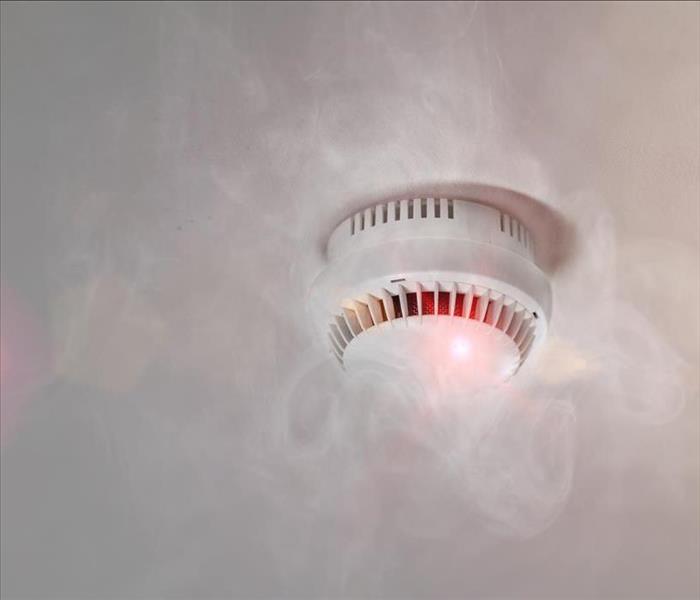 Smoke Alarms Oak Ridge
Smoke Alarms Oak Ridge
Smoke alarms save lives when properly installed and maintained, according to the National Fire Protection Association (NFPA).
In homes, smoke alarms should be in every bedroom, outside each sleeping area, and on every level, including the basement. Extra smoke alarms may be needed in large homes.
Test smoke alarms monthly using the test button. Smoke alarms with non-replaceable batteries need the entire smoke alarm unit replaced every ten years. Other alarms need batteries replaced every year, and the group replaced every ten years. If the alarm chirps are signaling low battery, take the proper steps to replace the unit or the batteries immediately.
Never disable or remove the battery from an alarm. Almost half of the fires where smoke alarms were present but did not activate had missing or disconnected batteries (NFPA).
If you need help installing, testing or changing batteries in your smoke alarms, contact your local fire department, an electrician or the American Red Cross.
Be sure your home has a fire emergency plan in place and conduct regular fire drills with your family.
For more information on Emergency Preparedness, contact your local SERVPRO® of Oak Ridge Professional.
Heating Safety Tips
2/17/2019 (Permalink)
 Heaters Can Cause Fire Damage
Heaters Can Cause Fire Damage
Keep anything flammable at least three feet away from heating equipment, like the furnace, fireplace, wood stove or a portable space heater. Have a three foot “kid-free zone” around open fires and space heaters.
-Make sure the fireplace has a sturdy screen to stop sparks from flying into the room. Ashes should be cool before putting them in a metal container. Keep the container a safe distance away from your home.
- Remember to turn portable heaters off when leaving the room or going to bed.
-Test smoke alarms monthly.
-Always use the right kind of fuel, specified by the manufacturer, for fuel-burning space heaters.
- Have heating equipment and chimneys cleaned and inspected every year by a qualified professional.
If your property does suffer fire damage, contact SERVPRO® of Oak Ridge.
Using a Portable Fire Extinguisher
12/3/2018 (Permalink)
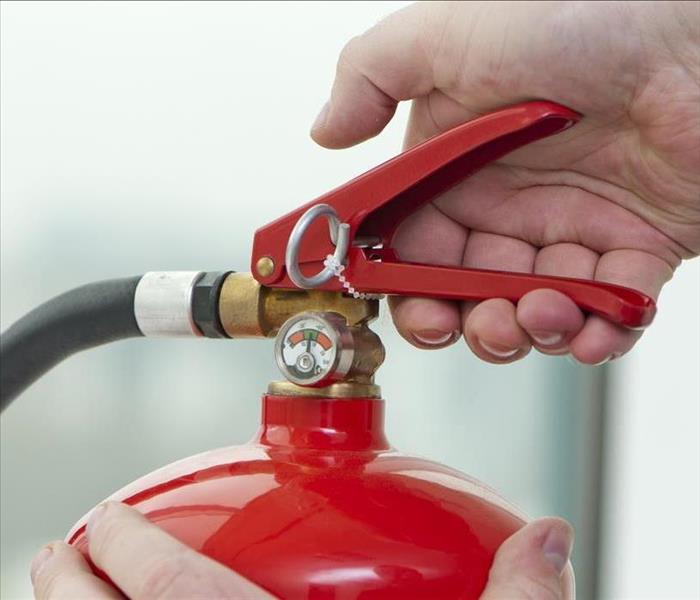 Fire Extinguisher
Fire Extinguisher
A portable fire extinguisher can be a life and property saving tool when used correctly. In order to operate an extinguisher, the National
Fire Prevention Association suggests remembering the word PASS:
-Pull the pin. Hold the nozzle pointing away from you and release
the locking mechanism.
-Aim low. Point the extinguisher at the base of the fire.
- Squeeze the lever slowly and evenly.
- Sweep the nozzle from side-to-side.
Read the instructions on the fire extinguisher and become familiar
with them before a fire breaks out. Remember, extinguishers do have
limitations. It is also important to ensure you have the correct type of extinguisher for your facility. For more information
on the different types of fire extinguishers and to ensure you have the proper one, visit nfpa.org.
Safety First Before You Eat
11/26/2018 (Permalink)
Each November, families gather to celebrate Thanksgiving by preparing a delicious feast, but if you don’t practice safe cooking habits, your happy holiday could become hazardous very quickly.
According to the National Fire Protection Association, cooking is the main cause for home fires and injuries, with Thanksgiving being the peak day for cooking-related fires.
Review the following safety tips to help ensure you can enjoy a safe holiday.
-Never leave cooking food unattended–stay in the kitchen when frying, grilling or broiling food. If someone must leave the kitchen for even a short period of time, they should turn off the stove.
-Check food regularly while cooking and remain in the home while cooking. Use a timer as a reminder that the stove or oven is on.
-Keep the kids away from the cooking area. Enforce a “kid-free zone” and make them stay at least three feet away from the stove.
- Keep anything flammable–pot holders, oven mitts, wooden utensils, paper or plastic bags, food packaging, and towels or curtains—away from the stove, oven or any other appliance in the kitchen that generates heat.
-Do not wear loose clothing or dangling sleeves while cooking.
-Clean cooking surfaces on a regular basis to prevent grease buildup.
- Purchase a fire extinguisher to keep in the kitchen. Contact the local fire department for training on the proper use of extinguishers.
-Always check the kitchen before going to bed or leaving the home to make sure all stoves, ovens, and small appliances are turned off.
-Install a smoke alarm near the kitchen, on each level of the home, near sleeping areas and inside and outside bedrooms. Use the test button to check it each month. Replace all batteries at least once a year.
SERVPRO® of Oak Ridge wishes you a safe
and happy holiday season.
Be Prepared This Summer
6/25/2018 (Permalink)
 Grill Fire
Grill Fire
Each year, families and friends across the country enjoy the summer months with barbecues, camping trips, or by cooling off in a pool or lake. To enjoy these occasions, it is important to keep safety top of the mind to ensure you have fun in the sun.
According to a recent study by U.S. Consumer Product Safety Commission, nearly 11,900 Americans were injured by fireworks in 2015., with the majority happening in the month surrounding the Fourth of July. Another 8,700 are injured by charcoal/wood-burning and propane grill fires. A grill should always be supervised when in use. Keep children and pets a safe distance from the grilling area to prevent accidental burns or tipping of the grill.
Grills also cause an average of 8,9000 home structure or outdoor fires. "These fires caused an annual average of 50 civilian injuries and $2 million in direct property damage," according to the National Fire Protection Association (NFPA).
If you enjoy lounging by the pool or going for a boat ride to cool off from the summer sun, make sure you exercise caution, especially when children are present. Only swim in approved areas and supervise children at all times when near water.
The summer season should be time to make memories and enjoy the great outdoors. Don't become a statistic. Take precautions to prevent these events from putting a damper on your summer months!
Celebrate Summer Safety
6/25/2018 (Permalink)
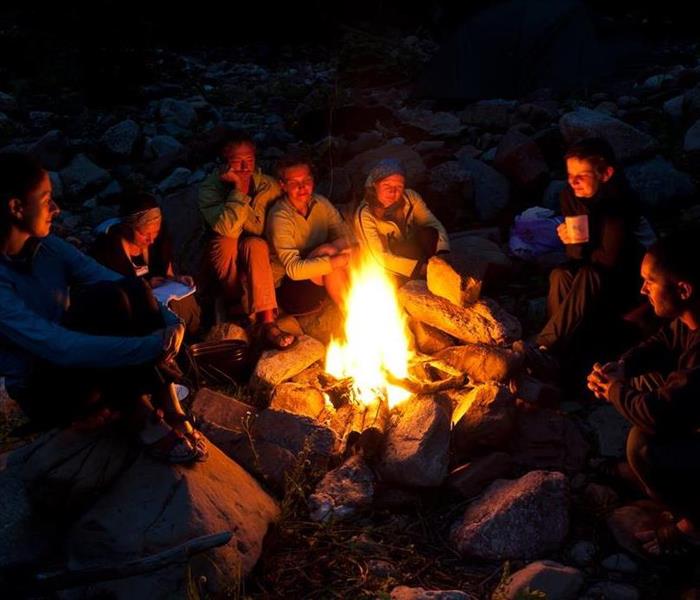 Campfire
Campfire
Summer is a time to enjoy the great outdoors, but it is also important to keep safety in mind. Consider the following tips, provided by the National Fire Protection Association, to keep you and your family safe all summer long.
-When using a charcoal grill, only use starter fluids designed for barbecue grills: do not add fluid after coals have been lit. When using a gas grill, ensure the hose connection is tight; check hoses for leaks. Applying soapy water to the hose will easily and safely reveal any leaks. When camping always use a flame-retardant tent and set up camp far away from the campfire.
-Always build campfire downwind from the tent area. Clear vegetation and dig a pit before building your fire. Extinguish the fire before going to sleep or leaving the campsite.
-Store liquid fire starter (not gasoline) away from your tent and campfire and only use dry kindling freshen a campfire.
Winter Season is Here
6/19/2018 (Permalink)
The winter season is here and with it comes shorter days and lower
temperatures. No matter where you live, winter brings a change in the weather. Many people use alternative heat sources like
fireplaces, portable space heaters, and wood burning stoves to help keep homes cozy. Did you know, heating equipment is a leading cause of home fire deaths?
According to the National Fire Protection Association, heating equipment fires cause an estimated $1 billion in direct property damage annually. Keep the following safety tips in mind to help reduce your risk of a
heating-related fire.
Keep anything flammable at least three feet away from heating equipment, like the furnace, fireplace, wood stove, or a portable space heater. Have a three foot “kid-free zone” around open fires and space heaters.
Make sure the fireplace has a sturdy screen to stop sparks from flying into the room. Ashes should be cool before putting them in a metal container. Keep the container a safe distance away from your home.
Remember to turn portable heaters off when leaving the room or going to bed.
Test smoke alarms monthly.
Always use the right kind of fuel, specified by the manufacturer, for fuel burning space heaters.
Have heating equipment and chimneys cleaned and inspected every year by a qualified professional.
If your property does suffer fire damage, contact your local SERVPRO® Franchise Professionals to help make it “Like it never even happened.”
How to Minimize Fire Damage
9/13/2017 (Permalink)
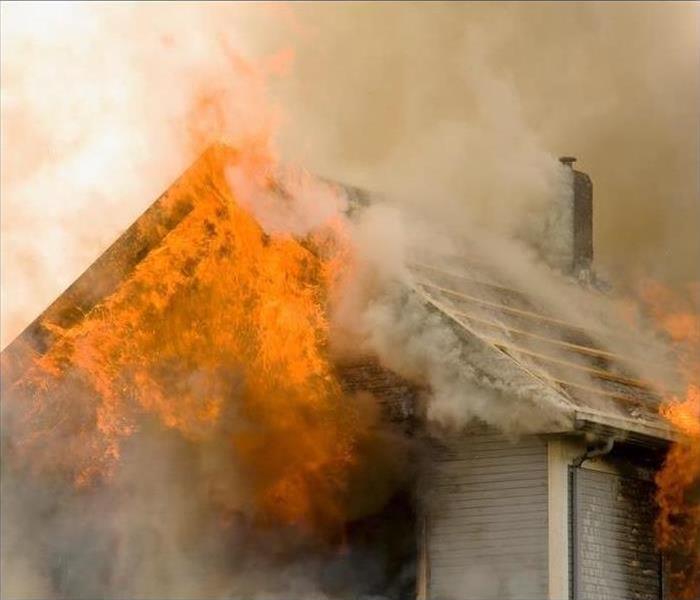 Fire Damage Oak Ridge
Fire Damage Oak Ridge
How to Minimize Fire Damage
Minimizing further fire damage is one of the first considerations after a fire in a home or a fire in a business. Commercial fire damage can greatly affect the ability of a business to continue operations. In order to recover as much value as possible from a property that has undergone fire damage, smoke damage, and soot damage, a restoration company should be contacted immediately after the premises are secure. The fire cleanup team can aid in evaluating the damage to the property and listing the items that are present. They can also perform fire damage restoration and offer an estimate on site.
A restoration company will also be instrumental in boarding up a property if commercial fire damage has compromised any doors or windows. Roofs and walls that may have been cut into by firefighters during the fire may also need to be boarded up. This process can be much more difficult than it originally appears due to the need to evaluate the structural integrity of much of the building's foundation. A professional contractor should be contacted before an individual attempts to board up his or her own property after a fire in a home or a fire in a business. Boarding up a property that has undergone fire damage is important both to prevent the collapse of the building as well as to protect it from any intruders who may cause additional damage.
The fire cleanup will also involve drying up all the water that firefighters may flood the premises with in order to put out the fire. This water can cause extensive water damage as well as promote the growth of mold. A certified technician can employ all manner of techniques to dry out the property and prevent mold growth using industrial equipment that may include a water extractor, a dehumidifier, and an air current mover. This process will also somewhat remove the smoke smell that may persist after a fire.
After a list of personal belongings have been identified and list along with the property owner, a restoration company can work with him or her to reverse the smoke damage and soot damage that may have settled into the property. Surfaces can often be fully cleaned, even if it is porous like carpet. Deep vacuuming and steam injection are often successful in removing the oily soot that may lead to residual smoke smell. Fire damage restoration requires techniques that require specialized equipment, and these techniques can be discussed with the property owner in order to decide whether or not to proceed with restoration.
If fire damage restoration is not possible on certain items, they may be more easily replaced. In this case, the restoration company will also help to dispose of these items in the appropriate manner. After a fire in a home or a fire in a business, much debris will need to removed anyway. Smoke damage and soot damage is reversible, but property owners sometimes choose to replace items and surfaces instead.
All surfaces are sanitized and cleaned after all soot damage and smoke damage has been reversed. The fire clean up team will also instruct property owners on how to prevent commercial fire damage in the future. Any residual smoke smell will be ventilated until gone. If the smoke smell persists, chemical solutions like an ozone treatment or thermal fogging are also options depending on the needs of the property owner. Additional treatments may be needed weeks or even months after the initial incident.
Fire cleanup is extremely daunting for an individual who is shocked by a fire in a home or a fire in a business. However, fire damage restoration is normal for a fire cleanup specialist, even after extension commercial fire damage. A specialist who has the experience and the expertise to guide a property owner will ensure that fire damage is minimized as much as possible.
Heating Hazards
6/15/2017 (Permalink)
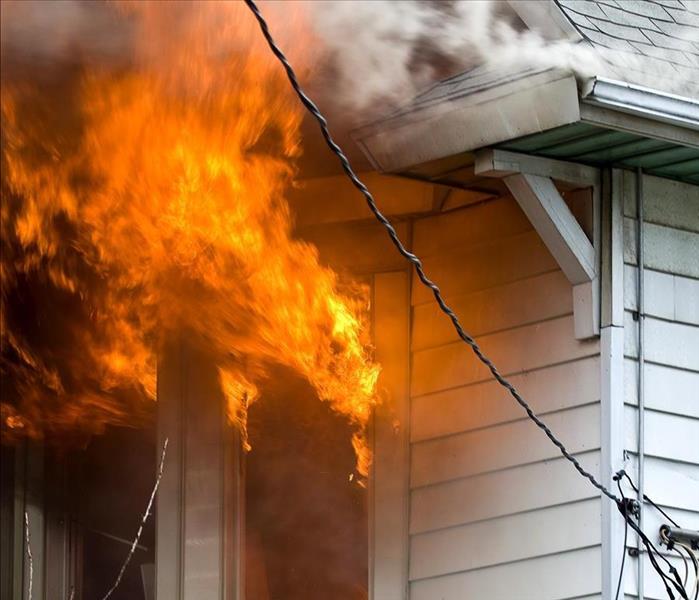 House Fire
House Fire
Eliminate Heating Hazards This Winter
The winter season is in full swing! The days are shorter and the temperatures are lower. No matter where you live, winter brings a change in the weather. In an effort to keep our homes and workplaces cozy, many people use alternative heat sources like fireplaces, portable space heaters, and wood burning stoves. According to the Nation Fire Protection Association, heating equipment is responsible for an estimated $893 million in property damage annually. Heating is the second leading cause of residential fire deaths, making it important to review ways to help reduce the risk of a heating-related fire.
Keep anything flammable at least three feet from heating equipment, like the furnace, fireplace, wood stove, or a portable space heater. Have a three-foot “kid-free zone” around open fires and space heaters.
Remember to turn portable heaters off when leaving the room or going to bed.
Always use the right kind of fuel, specified by the manufacturer, for fuel-burning space heaters.
Make sure the fireplace has a sturdy screen to stop sparks from flying into the room. Ashes should be cool before putting them in a metal container. Keep the container a safe distance away from your home.
Have heating equipment and chimneys cleaned and inspected every year by a qualified professional.
Have a qualified professional install stationary space heating equipment, water heaters or central heating equipment according to the local codes and manufacturer’s instructions.
Test smoke alarms monthly.
Holiday Fire Season
6/14/2017 (Permalink)
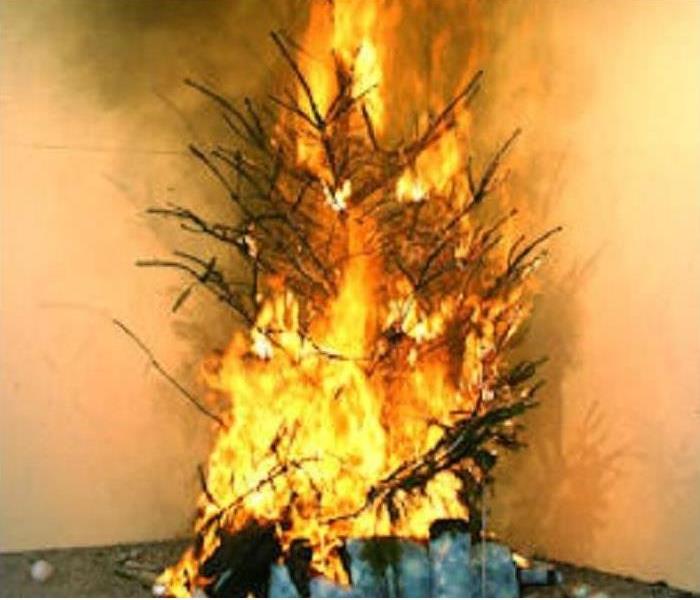 Fire Damage
Fire Damage
It's the holiday season again. Brightly lit decorations, elaborate meals, and large gatherings are all a part of holiday celebrations. Unfortunately, these annual traditions also cause an average of 230 homes fires each year, with an average of 4 deaths, 21 injuries, and $17.3 million in property damage.
There are about 3 times as many cooking related fires on Thanksgiving Day and almost twice as many on Christmas Day as there on no holidays. Luckily, homeowners can help keep their homes and their families safe during the holiday season by understanding the dangers.
Holiday Cooking Fire Facts from SERVPRO
- Thanksgiving Day has three times the average number of reported home structure fires involving cooking equipment.
- The two other peak days for cooking-related fires are Christmas Day and Christmas Eve.
Holiday Cooking Safety Tips from SERVPRO
- Supervise items on the stovetop. Fifty-eight percent of kitchen fires involve ranges; homes with electric cooktops have a higher risk of fire than homes with gas cooktops.
- Keep flammable items – potholders, packaging, wrapping, wooden utensils, loose clothing – away from the stovetop.
- Don’t let lack of sleep or alcohol consumption affect your ability to concentrate on preparing the meal.
Holiday Decorating Fire Facts from SERVPRO
- Half of all holiday decoration fires start because the decoration is too close to a heat source.
- On average, 32 candle fires are reported each day. December is the peak month for candle fires.
Holiday Decorating Safety Tips from SERVPRO
- Keep all decorations away from heat sources like radiators, portable heaters, and fireplaces.
- Use flameless candles.
- If you do use traditional candles, burn them in sturdy candleholders, well away from drapes and other flammable materials. Never leave them unattended and never allow them to burn down to less than one inch in length.
Christmas Tree Fire Facts from SERVPRO
- 50% of live tree fires occur between December 22 and January 5.
- 31% of tree fires are caused by electrical problems.
- 14% involve decorative lights.
Christmas Tree Safety Tips from SERVPRO
- Keep live trees well watered to reduce the chance of a fire.
- Check wiring on lights for breaks and wear, replace worn strings and don’t exceed manufacturer guidelines for connecting multiple strands of lights.
- Don't leave tree lights plugged in when you are away from home or asleep.





 24/7 Emergency Service
24/7 Emergency Service












